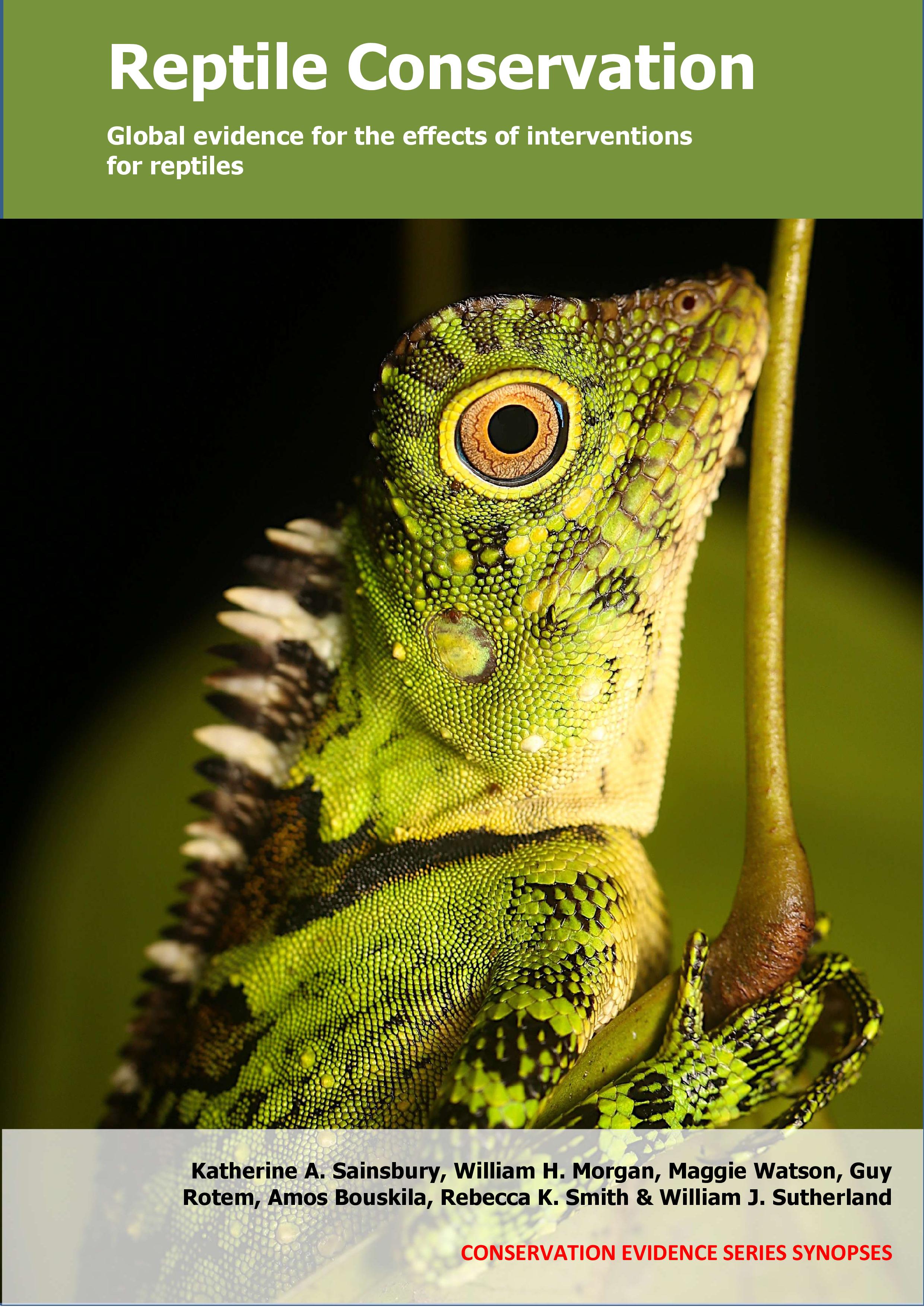Actions to conserve biodiversity
We have summarised evidence from the scientific literature about the effects of actions to conserve wildlife and ecosystems.
Review the evidence from the studies
Not sure what Actions are? Read a brief description.
Search for evidence
e.g. "frogs chytrid"
312 Actions found
Refine
Hide
312 Actions found
Download Actions
| 0 selected |
|
Order results by:
| Action | Effectiveness | Studies | Category | |
|---|---|---|---|---|
|
Rehabilitate and release injured or accidentally caught individuals: Tortoises, terrapins, side-necked & softshell turtles Action Link |
Awaiting assessment | 4 |
|
|
|
Rehabilitate and release injured or accidentally caught individuals: Snakes & lizards Action Link |
No evidence found (no assessment) | 0 |
|
|
|
Rehabilitate and release injured or accidentally caught individuals: Crocodilians Action Link |
Awaiting assessment | 1 |
|
|
|
Rehabilitate and release injured or accidentally caught individuals: Tuatara Action Link |
No evidence found (no assessment) | 0 |
|
|
|
Breed reptiles in captivity: Sea turtles Action Link |
Awaiting assessment | 2 |
|
|
|
Breed reptiles in captivity: Tortoises, terrapins, side-necked & softshell turtles Action Link |
Awaiting assessment | 28 |
|
|
|
Breed reptiles in captivity: Snakes – Boas and pythons Action Link |
Awaiting assessment | 12 |
|
|
|
Breed reptiles in captivity: Snakes – Colubrids Action Link |
Awaiting assessment | 18 |
|
|
|
Create or restore forests Action Link |
Awaiting assessment | 6 |
|
|
|
Breed reptiles in captivity: Snakes – Elapids Action Link |
Awaiting assessment | 4 |
|
|
|
Create or restore shrubland Action Link |
Awaiting assessment | 1 |
|
|
|
Restore beaches Action Link |
Awaiting assessment | 1 |
|
|
|
Breed reptiles in captivity: Snakes – Vipers Action Link |
Awaiting assessment | 13 |
|
|
|
Create or restore waterways Action Link |
Awaiting assessment | 2 |
|
|
|
Create or restore wetlands Action Link |
Awaiting assessment | 7 |
|
|
|
Breed reptiles in captivity: Lizards Action Link |
Awaiting assessment | 23 |
|
|
|
Breed reptiles in captivity: Crocodilians Action Link |
Awaiting assessment | 6 |
|
|
|
Breed reptiles in captivity: Tuatara Action Link |
Awaiting assessment | 1 |
|
|
|
Use artificial insemination Action Link |
Awaiting assessment | 1 |
|
|
|
Freeze sperm or eggs for future use Action Link |
No evidence found (no assessment) | 0 |
|
|
|
Alter incubation temperatures to achieve optimal/desired sex ratio: Sea turtles Action Link |
Awaiting assessment | 1 |
|
|
|
Alter incubation temperatures to achieve optimal/desired sex ratio: Tortoises, terrapins, side-necked & softshell turtles Action Link |
Awaiting assessment | 8 |
|
|
|
Alter incubation temperatures to achieve optimal/desired sex ratio: Snakes & lizards Action Link |
Awaiting assessment | 4 |
|
|
|
Alter incubation temperatures to achieve optimal/desired sex ratio: Crocodilians Action Link |
Awaiting assessment | 3 |
|
|
|
Alter incubation temperatures to achieve optimal/desired sex ratio: Tuatara Action Link |
Awaiting assessment | 2 |
|
Download Actions
| 0 selected |
|

Reptile Conservation - Published 2021
Reptile synopsis
Watch this search
If you are familiar with RSS feeds, please click the button below to retrieve the feed URL:
RSS feed for this searchIf you are unfamiliar with RSS feeds, we would suggest reading this BBC article.
Unfortunately, due to the number of feeds we have available, we cannot provide e-mail updates. However, you could use tools such as Feed My Inbox to do this for you.
What are 'Individual studies' and 'Actions'?
Individual studies
An individual study is a summary of a specific scientific study, usually taken from a scientific journal, but also from other resources such as reports. It tells you the background context, the action(s) taken and their consequences.
If you want more detail please look at the original reference.
Actions
Each action page focuses on a particular action you could take to benefit wildlife or ecosystems.
It contains brief (150-200 word) descriptions of relevant studies (context, action(s) taken and their consequences) and one or more key messages.
Key messages show the extent and main conclusions of the available evidence. Using links within key messages, you can look at the paragraphs describing each study to get more detail. Each paragraph allows you to assess the quality of the evidence and how relevant it is to your situation.
Where we found no evidence, we have been unable to assess whether or not an intervention is effective or has any harmful impacts.





)_2023.JPG)














